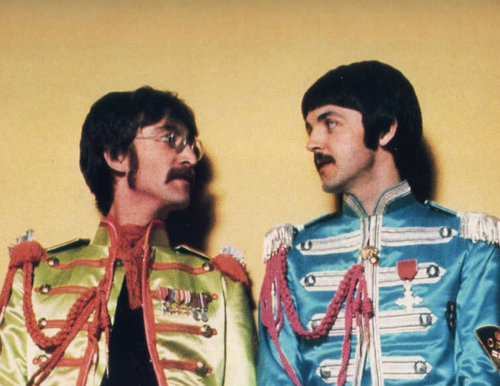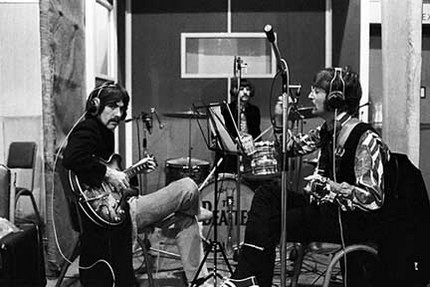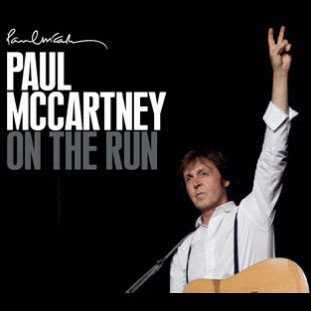
www.rollingstone.com
Beatles' 'Sgt. Pepper' at 50: John Lennon's Accidental 'Getting Better' Acid Trip
Lennon swallowed the wrong pill the night he was supposed to record backing harmonies for the song. Weirdness – and male bonding – ensued
By Jordan Runtagh
19 may 2017

Read the story of John Lennon's accidental acid trip during the recording of the 'Sgt. Pepper' song "Getting Better."
The Beatles' Sgt. Pepper's Lonely Hearts Club Band, which Rolling Stone named as the best album of all time, turns 50 on June 1st. In honor of the anniversary, and coinciding with a new deluxe reissue of Sgt. Pepper, we present a series of in-depth pieces – one for each of the album's tracks, excluding the brief "Sgt. Pepper's Lonely Hearts Club Band" reprise on Side Two – that explore the background of this revolutionary and beloved record. Today's installment looks back on the night John Lennon accidentally dosed himself with acid before a recording session for "Getting Better."
It could be argued that "Getting Better" is the most perfect of all latter-day John Lennon and Paul McCartney collaborations. Sure, "A Day in the Life" gets the prestige, but the fourth track on Sgt. Pepper's Lonely Hearts Club Band beautifully illustrates their very different characters. While the song was being recorded that spring, an odd incident would further fuse their souls on a psychedelic level.

McCartney devised the title while walking his sheepdog Martha through London's Regent's Park in early 1967. He was joined by journalist Hunter Davies, then shadowing the Beatles while working on their official biography. "It was the first spring-like morning of that year, and as we got to the top of the hill, the sun came up," Davies relayed to Steve Turner in his book, A Hard Day's Write. "[Paul] turned to me and said, 'It's getting better,' meaning that spring was here. Then, he started laughing and I asked him what he was laughing about." McCartney recounted a story about Jimmie Nichol, a drummer who played with the band for 10 concert dates on their 1964 world tour while Ringo Starr recovered from tonsillitis and pharyngitis. When asked how he was adapting to the insanity of Beatlemania, the good-natured Nichol would reply, "It's getting better!" The phrase, and all its earnestness, became something of an in-joke among the band.
When McCartney suggested they write a song around the optimistic line, Lennon's contributions brought the hopeful lyrics crashing back to Earth. "I was sitting there doing, 'Getting better all the time,' and John just said in his laconic way, 'It couldn't get no worse,'" McCartney told friend Barry Miles in the biography, Many Years From Now. "I thought, 'Oh, brilliant! This is exactly why I love writing with John." Lennon also took the opportunity to add a disturbing confessional to the final verse. "All that, 'I used to be cruel to my woman, I beat her and kept her apart from the things that she loved,' was me," he told Playboy in 1980. "I used to be cruel to my woman, and psychically, any woman. I was a hitter! I couldn't express myself and I hit. I fought men and hit women."

The Beatles worked out the song's instrumental track during two sessions at EMI's Abbey Road studios before arriving – sans Ringo Starr – on the evening of March 21st, 1967, to record the backing harmonies. To prepare himself for yet another marathon all-night session, Lennon reached into his silver art-nouveau pillbox and pulled out what he thought was an amphetamine. Unfortunately, he accidentally picked the wrong tablet, dosing himself with LSD. "It'll certainly keep him awake for a while!" Harrison wryly noted on a 1992 episode of ITV's The South Bank Show.
"I thought I was taking some uppers and I was not in the state of handling it," Lennon told Rolling Stone in 1970. "I said, 'What is it, I feel ill?' I thought I felt ill and I thought I was going cracked ... then it dawned on me that I must have taken some acid." He informed producer George Martin that he was unwell. Never guessing that Lennon's troubles were pharmaceutical in origin, the older gentleman responded with old-fashioned common sense. "'Come on, John,' I said, 'What you need is a good breath of fresh air!'"

With unnatural intensity, Lennon began to climb the staircase from the studio floor to meet Martin in the control room above. "It seemed to take John a long time to get up the stairs; he was moving as if he were in slow motion," recalled engineer Geoff Emerick in his book, Here There and Everywhere: My Life Recording the Music of the Beatles. "When he finally walked through the doorway into the control room, I noticed that he had a strange, glazed look on his face. He appeared to be searching for something, but didn't seem to know what it was. Suddenly he threw his head back and began staring intently at the ceiling, awestruck. With some degree of difficulty, he finally got a few not especially profound words out: 'Wow, look at that.' Our necks cranked upward, but all we saw was ... a ceiling."
Martin led his befuddled charge up through a series of passageways to the platform on top of EMI's studios for what would become the second-most famous rooftop incident in the Beatles saga. Martin, naïve to the world of drugs, was still unclear what was the matter, though he did notice Lennon "swaying gently against my arm and resonating like a human tuning fork" – a condition that isn't usually cured by fresh air. "If I'd known it was LSD, the roof would have been the last place I would have taken him!" he laughed in the Beatles Anthology documentary. "But of course I couldn't take him out the front because there were 500 screaming kids who'd have torn him apart. So the only place I could take him to get fresh air was the roof. It was a wonderful starry night, and John went to the edge, which was a parapet about eighteen inches high, and looked up at the stars and said, 'Aren't they fantastic?' Of course to him I suppose they would have been especially fantastic. At the time they just looked like ordinary stars to me."

Several minutes later Martin returned to the studio to continue work, leaving Lennon to his own devices on the roof. McCartney and Harrison, well aware of what their bandmate had done, carried on for a short time before they grasped the full impact of the situation: Lennon was tripping alone on an unguarded roof! Instantly they sprinted up the stairs to rescue him. "They knew all too well that the rooftop had only a narrow parapet and that, in his lysergically altered state, John could easily step over the edge and plummet thirty feet to the pavement below," Emerick writes. Thankfully, Lennon was found intact, quietly contemplating the universe on his own.
Safely back in the studio, Lennon realized he was in no state to record. "I said, 'Well, I can't go on. You'll have to do it and I'll just stay and watch,'" he later told Rolling Stone. "I got very nervous just watching them all, and I kept saying, 'Is this all right?' They had all been very kind and they said, 'Yes, it's all right.'" The session recommenced briefly, but soon it was deemed useless without a capable Lennon and the group decided to break early for the night.

But there was a problem. Lennon's driver wasn't due to return to Abbey Road for several hours, and his wife Cynthia was fast asleep. To keep watch over his vulnerable friend, McCartney decided to take him back to his own home on Cavendish Avenue, a short walk from the studio. "Paul's thoughtfulness in going home with John was typical of one of the best sides of his character," Martin reflected in his memoir, All You Need Is Ears.
"I thought, maybe this is the moment where I should take a trip with him." –Paul McCartney
The good deed caused something of a dilemma for McCartney, who was perhaps the least enthusiastic acid taker of the band. "I was really frightened of that kind of stuff," he said in The Beatles Anthology. "It's what you're taught when you're young: Watch out for those devil drugs. When acid came around, we'd heard you're never the same. It alters your life and you're never the same again. I think John was rather excited by that prospect, [but] I was rather frightened by that prospect. Like, 'Just what I need, some funny little thing where I can never get back home again.' Might not be the greatest move. So I was seen to stall a little bit within the group."

McCartney's abstinence caused a rift, and for a time the previously impenetrable foursome found themselves on vastly different wavelengths. "Within a band, it's more than peer pressure, it's fear pressure," he related to Miles. "More than just your mates it's, 'Hey, man, this whole band's had acid, why are you holding out? What's the reason, what is it about you?'" He eventually experimented with the drug with his friend, Guinness heir and socialite Tara Browne, in December 1965 (some sources say 1966), and his reaction was mixed. Though allowing that it was "amazing" and "a deeply emotional experience," in the same breath he admits he was "never that in love" with the substance. "For a guy who wasn't that keen on getting that weird, there was a disturbing element to it."
As he and Lennon made the quick trip to his Regency townhouse in the early hours of March 22nd, McCartney made a snap decision. "I thought, maybe this is the moment where I should take a trip with him," he recalled. "It's been coming for a long time. It's often the best way, without thinking about it too much, just slip into it. John's on it already, so I'll sort of catch up. It was my first trip with John, or any of the guys. We stayed up all night, sat around and hallucinated a lot. Me and John, we'd known each other for a long time. Along with George and Ringo, we were best mates. And we looked into each other's eyes, the eye contact thing we used to do, which is fairly mind-boggling. You dissolve into each other. ... And it was amazing. You're looking into each other's eyes and you would want to look away but you wouldn't, and you could see yourself in the other person. It was a very freaky experience and I was totally blown away. John had been sitting around very enigmatically and I had a big vision of him as king, the absolutely Emperor of Eternity. It was a good trip."

John Lennon describes the first time he took LSD. LSD opened the door to the Beatles' masterpiece 'Revolver' – but also opened wounds that never healed. Watch here.

No hay comentarios:
Publicar un comentario